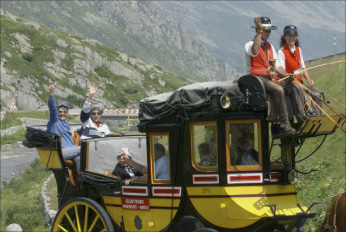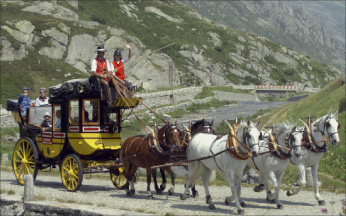The Gotthard stagecoach
The Gotthard stagecoach
The most beautiful vehicle in Switzerland
by Heini Hofmann
When the last Gotthard postilion climbed off the box, a great and dynamic era of transalpine postal connections came to an end. Today, this adventure from long ago can be experienced the touristic way in a true to original, eight-seater Landau Coupé drawn by five horses (three leaders and two wheelers).

After more than half a century in operation, the horse-drawn Gotthard stage was ceased on 1 June 1882 since there was a competition with the railway tunnel. In 1909, it experienced another comeback for tourists, to which in 1922 the “Postauto” put an end again. But thanks to private initiative there is a historical travel post again since 1988, which offers nostalgic trips from Andermatt via Hospiz to Airolo in the summer months.
A nostalgic revival
Today it appears as if it would be from another star, the yellow stage coach, waiting for passengers at Andermatt station with five harnessed, impatient steeds. As 150 years ago, passers-by and tourists wave to the passengers like crowned heads. After a first stop for an apero halt in the middle of Andermatt, where poet prince Goethe had already descended (who raved about the Urseren valley that it was the “dearest and most interesting” of all areas he knows), the trip leads to Hospental, where the mountain route begins. Up in Mätteli, there is a rest for the horses and refreshment for the passengers. They change after each such stop between coupé compartment under the coach box, middle cabin, and rear high seat.
Over and again the great amazement of the other road users: Cars shift to crawling gear, and motorcyclists climb off their petrol horses to take pictures of the oat-horses. Wherever possible, however, the team changes to the old pass road like at Brüggloch, where they already cross the border to the canton of Ticino at a trot. Lunch is served at the Gotthard Hospice, where the guests enjoy a multi-course meal in the old “Sust” and the steeds outside enjoy a one-course oat meal from their head bag. Afterwards, in the Gotthard Museum revives the time of ages ago, and all participants receive a stamped nostalgia ticket as a souvenir.
Via Tremola to Merenda
Then downhill again, over the narrow, cobbled serpentines of the Tremola, through the sky curve that also Rudolf Koller immortalised in his famous Gotthardpost painting. Today, however, disc brakes that the rebuilt carriage is equipped with, make the difficult task easier for the postilion and the horses. Via Motto Bartola the team reaches the station Airolo in the Leventina, where passengers, postilion, conductor, and escort team (always discreetly in the background with a minibus and farriery) bid farewell with a Merenda, a Ticino afternoon snack.
While horses and carriage with transporter and trailer drive back on the road, home to the stables of the historic travel post in a former military building outside of Andermatt, the passengers enriched by a tremendous experience travel back by train and dream of those times when the Gotthard Post was still reality.
The first beginnings
It was the construction of the road through the Schöllenen, the Tremola, and other narrow ways in the Leventina alone that made it possible to travel by horse-drawn carriages on the St Gotthard Pass, one of the most important north-south connections over the European high mountains. From 1830, the pass was cautiously frequented by two-seater coaches. The bottleneck now still was the limited capacity of the messenger ships between Lucerne and Flüelen (Axenstrasse still non-existent). The cumbersome rowing boats equipped with sails could only accommodate five passengers, travelled only twice a week and took twelve hours to cross from Lucerne to Flüelen. This changed when steamships began operating on Lake Lucerne in 1837, reducing the journey time to less than three hours.
Passenger numbers and postal freight now increased continuously so that from 1842 a five-horse eight-seater stagecoach ran daily in both directions between Chiasso and Flüelen. In winter, the pass was also kept open and the mountain route was done with sledge convoys then. One hundred “Ruttner” (roadmen) and one hundred sledge menials found work on each side of the Hospiz. In 1847, the completion of the Melide causeway made the cumbersome trajectory ferries between Melide and Bissone redundant. As the Federal Constitution of 1848 abolished internal customs duties and cantonal currencies, the entire Gotthard route from Basel to Chiasso for the first time was under unified overall leadership since 1849.
Prosperity and end
In the middle of the century, 1850, the Swiss Post extended the Gotthard line to the railway station of Camerlata south of Como, then the final destination of the railway line from Milan to Switzerland. This gave the Gotthard Postal Course the surname “Milan”. Now the newly built, federal stagecoaches were called into action for the first time. The journey from Basel via the Gotthard to Milan still took about 50 hours. A combined return ticket cost 68,60 Swiss Francs, which was equivalent to the wage of a stagecoach driver for three months. As increasingly more pleasure-travellers crowded over the Gotthard, an additional “master course” was established in 1864, and for impatient businessmen a nocturnal “express course”.
Passenger numbers rose steadily, from around 14,000 in 1849 (following the introduction of the new Federal Constitution) to just over 25,000 in 1861. Ten years later, there were already 42,000 stagecoach passengers. According to Rudolf Koller’s cult painting, the maximum number of passengers was 72,000 in 1875. After that things went downhill: in 1880 there were still around 61,500, and in the last full year of operation, 1881 only 58,500. From commissioning the Gotthard Railway both, passengers and mail items were transported through the railway tunnel between Göschenen and Airolo expeditiously. On 1 June 1882 fate has decided: The horse stagecoach was closed – the end of a great era!
Spectacular events
Many great but also many tragic events remain in the annals of the hippo-mobile alpine traversing with the Gotthard post. The most exciting extra trip was probably that of the Russian tsarina when she and her entourage crossed Switzerland from Rorschach to Magadino via the Gotthard Pass on their journey to Nice in October 1856. The retinue consisted of no less than seven coaches and six, two four-in-hand and two forerunners, whose task it was to order horses, meals and overnight stays. No less than 52 horses were needed at each changing station. The tsarina seemed impressed by the service offered, since she gave a gold watch with chain to the conductor in charge.
Less fortunate was the Camerlata-Flüelen night ride of 22 November 1862, when a band of robbers stole the post van, money, and watches. When they tried to sell it off in Ghiffa on Lake Maggiore, the bandits could be arrested. Even worse was the attack of 13 October 1864 also on a night ride on Monte Ceneri, an area that was long considered unsafe. The conductor was tied up, the postillion shot at. He later succumbed to his injuries. The travellers had to debouch their watches, jewellery and purses. Subsequently, the head of the robber band could be arrested in Milan.
Nevertheless, also the nature exacted its toll. In November 1874, an avalanche in the Tremola buried the Gotthard post sledge convoy, which consisted of 10 horse drawn sleighs and 23 travellers. The conductor could only be rescued dead. In January 1879, another avalanche in the Tremola curves hit 8 of the 11 horse-drawn sleighs on the post course. This time all travellers were lucky, not so 2 horses that perished under the snow masses.

A temporary bread basket
The passage of the stagecoach always was the main event of the day. Post horn signet and horse bells, the trampling of the hooves, rumbling of the wheels, groaning of the axles and screeching of the brakes, mixed with the yelp of dogs, attracted people to the windows or to the village square, where there were news to learn and strangers in sophisticated robes to marvel at.
The Gotthard stagecoach (the last original horse post wagon can still be seen at the National Museum in Zurich) was also a bread basket for countless families, directly for employees and vehicle owners and indirectly for those in road maintenance and winter road clearance services. When suddenly the postal traffic over the pass was stopped, this vital source of income dried up for the population just as abruptly. Entire families and many young people were forced to emigrate to America. Those who were driving through the railway tunnel now did not notice though... •
(Translation Current Concerns)
Postilion and conductor
HH. Although the postilions were the real heroes of the event, they ranked below the conductors. They were simple charioteers who were exchanged at the horse mail stations (relays) together with the (horse-drawn) stagecoaches. That happened no less than twelve times on the route between Flüelen and Camerlata. A postilion did not necessarily have to be able to read and write, but he had to blow the post horn. He had to master service signals such as departure and arrival of the mail, number of wagons or sledges and horses (for crossing and preparing the changes), but of course also some pieces of entertainment.
The primarily responsible and better-off in the hierarchy was the conductor who covered the entire route. As supervisor, he was responsible for the adherence of the timetable, changing horses and for transporting the mail. From 1852, he was also responsible for the surveillance of the telegraph line along the postal route. And, of course, he was the travellers’ ombudsman. Equally important were the postal horse owners in Andermatt and Airolo, who worked as contractors for Swiss Post. They provided the necessary number of horses including the postilion at the stages. In the best times there were up to a hundred horses in the stable between Flüelen and Gotthard Hospiz alone!
(Translation Current Concerns)